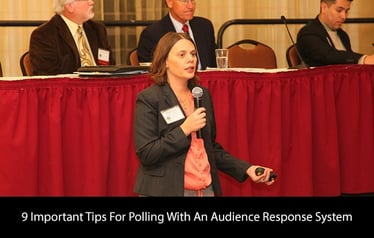
When polling or surveying with an Audience Response System, there are key elements to keep in mind to ensure that all information is admissible and appropriate for its intended purpose. The following nine steps to developing a questionnaire or survey will help to ensure that accuracy with your interactive response system or planning an interactive event.
- Determine what information will be sought from the questionnaire--Are you using the audience polling system to measureemployee satisfaction or perceptions? Are you determining retention of meeting or training information? Are you sampling decision makers to determine the correct course of action? This will help keep the questions focused and clear to the respondents.
- Decide on a method of administration--This may be the degree of structure or disguise; how aware the participants are of the purpose of the study. Do they know if their results will help them or hinder them?
- Choose the content of the individual questions--Focus on importance and necessity. Determine if the information can be gathered from one question or if multiple are necessary. For example: Satisfaction requires multiple questions; “How do you feel at work?” “How do you feel you connect to the rest of the employees?” Retention, however, requires one: “How do you address this situation?” Make sure respondents will have and be able to provide the desired information. This may be accomplished with the use of filter questions. Filter questions make sure respondents are appropriate sources of information. For example, when studying frequencies of gasoline purchases, it would be appropriate to ask if respondents drove or filled up their own vehicles. Recall loss is a concern with gathering information as respondents may forget an event ever happened. To prevent this, it is helpful to distribute questionnaires as close to the event being questioned as possible. Similarly, telescoping error occurs when people remember an event as happening more recently than is true and is may be reduced in the same manner as recall loss.
- Determine the format in which responses need to be collected--There are two types of questions. Open-ended questions allow more information to be gathered. This would be a short-response or text-based response question. Closed-ended questions seek a simple answer. These would include multiple-choice questions. This also needs to take into account what type of keypads have been purchased or rented as some allow for text answer submissions and others don’t.
- Pick wording for each question--It is important to use simple wording. Avoid ambiguous words or questions and leading questions. It is important that all questions are presented as neutral in order to gather pure response data. For this reason, eliminate generalizations and assumed consequences. Double-barreled questions may also skew data as they ask about more than one thing at a time. Try to avoid forcing respondents into estimating their responses. Use appropriate scaling in setting answers to questions. For example: Set 1 as “Unlikely,” 2 as “Equally Unlikely and Likely,” and 3 as “Likely.” Questions worded as “How happy are you working here?” can skew data and prevent accurate results, preventing problem identification and reconciliation.
- Decide on the sequence of the questions--Opening questions should be simple and interesting to participants. Utilize the funnel approach by starting with broad questions and becoming more specific as the questionnaire progresses. Be aware of question order bias. Save sensitive or more difficult questions until the end and have classification questions close out the survey. For training sessions, start with “How do you greet a customer?” and move to “Which of the following is the best response to a customer complaint?”
- Adjust the appearance of the survey--Keep the survey short and clutter-free. Use numbers and sections to organize questions. Use short, specific instructions and include an organization name and the title of the project.
- Create an introduction--The introduction should briefly explain who you are, why you are conducting the survey, a promise ofconfidentiality or anonymity, an estimate of the time it will take to complete, an explanation of incentives or compensation if any will be provided, and a statement of gratitude for participation. This keeps employees from worrying if their responses could impact them negatively.
- Pre-test and revise the survey--This is necessary to make sure all data collected will be accurate and useful. Data is never to be collected until the questionnaire has been pre-tested. Make sure employees understand how the survey is set up before presenting it in a meeting for use.


